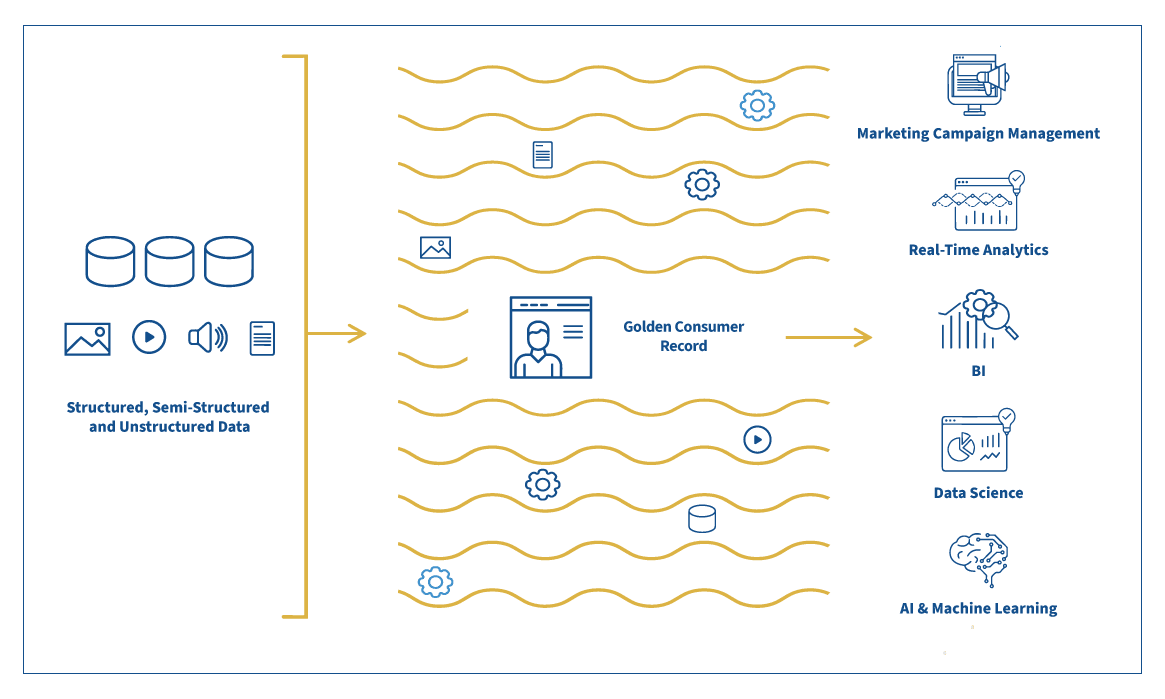
This article is the first in a thought leadership series from the team at DDG focused on the evolving role of data in marketing. We explore the concept of a Marketing Data Lakehouse—what it is, why it matters, and how it can help marketing teams get more value from their data across targeting, attribution, personalization, analytics, and AI. This article is intentionally non-technical to ensure accessibility to business and marketing teams.
WHAT IS A DATA LAKEHOUSE?
The Evolution of Data Solutions – From Data Warehouses to Data Lakes to Data Lakehouses
Initially, organizations relied on data warehouses to store structured data for business intelligence purposes. While effective for reporting, these systems struggled with handling large volumes of unstructured or semi-structured data.
Data lakes emerged to address this limitation by storing raw data from multiple sources in its native format. However, they often lacked governance and efficient querying capabilities, leading to data silos and inconsistencies.
A data lakehouse bridges these gaps by integrating the strengths of both data lakes and data warehouses, enabling unified governance, comprehensive data management, and high-performance analytics and AI.
Key Features of a Data Lakehouse
- Unified, Scalable Strorage – Consolidates structured and unstructured data into a single repository.
- Real-Time and Batch Processing – Supports both real-time streaming and batch analytics.
- Advanced AI and Machine Learning – Facilitates predictive analytics and automation.
- Open Data Formats – Eliminates vendor lock-in and allows flexible integrations.
- Data Governance & Security – Provides access controls, compliance tracking, and data quality management.
What is a Marketing Data Lakehouse?

A marketing data lakehouse is a specialized version of a data lakehouse tailored to the unique needs of marketing teams focused on customers and prospects. By integrating customer data across multiple channels—terrestrial, email, digital ads, CRM systems, web analytics, and more—it provides a centralized, accessible platform that enables all major down-stream marketing activities:
- Golden Record – Unifying prospect and customer data for better decision-making, segmentation, targeting, and personalization through a true 360 degree view of the consumer.
- Marketing Campaign Management – Track and optimize true marketing ROI by analyzing performance across multiple channels in real-time.
- Business Intelligence (BI) – Enable advanced reporting and dashboards that provide deep insights into customer behavior, campaign performance, and sales attribution.
- Real-Time Analytics – Process and analyze data streams instantly to respond to market trends, customer interactions, and campaign performance as they happen.
- Personalized Customer Experience (CX) at Scale – Analyze customer journeys and interactions across channels to enable real-time personalization and maximize cross-sell and up-sell conversions.
- Data Science – Leverage structured and unstructured data to uncover patterns, develop predictive models, and enhance marketing strategies.
- AI & Machine Learning – Automate marketing processes, optimize targeting, and predict customer behavior through advanced AI-driven insights.
Why Traditional CDPs Fall Short
Many companies have turned to Customer Data Platforms (CDPs) to unify customer data. However, 90% of marketers report that their CDPs don’t meet their needs (MarTech). Traditional CDPs often fail to deliver on their promise.
Lakehouse VS. CDPSolving the Limitations |
||
|---|---|---|
| CDP Limitation | How Traditional CDPs Fall Short | How a Marketing Data Lakehouse Solved CDP Limitations |
| Rigid Data Models | Predefined schemas restrict flexibility and adaptability to custom business needs. | Uses schema-on-read, allowing flexible modeling based on the use case and supporting both structured and semi-structured data. |
| Lack of Advanced Analytics | Designed primarily for segmentation and activation, not deep data science or modeling. | Built to support advanced analytics, AI, predictive modeling, and BI. Integrates with key tools like Python, MLlib, TensorFlow, and PyTorch among others. |
| Challenges with Offline Data | Struggles to ingest and standardize postal data, names, and transactions, leading to duplication and poor identity resolution. | Supports third-party data readiness solutions (like those offered by DDG) to clean, match, and enrich offline data, creating a true golden record. |
| Persistent Data Silos | Stores data in closed environments, limiting access across teams and enterprise systems. | Open and fully interoperable architecture enables bi-directional flows with enterprise lakes, warehouses, and analytics environments. |
| Security & Privacy Risks | Often requires pushing first-party data outside company firewalls into third-party systems. | Data stays within your environment. |
What’s Next: Turning Your Lakehouse Into a Growth Engine
Now that we’ve defined what a marketing data lakehouse is and why it’s a step beyond traditional CDPs, it’s time to look at the results it can deliver. In the next blog, we’ll explore how a marketing data lakehouse transforms marketing performance—from creating a true 360 degree view of the customer and improving campaign ROI, to enabling advanced targeting, personalization, and automation. Discover how leading brands are using this approach to turn marketing data into measurable impact.
Stay tuned.
